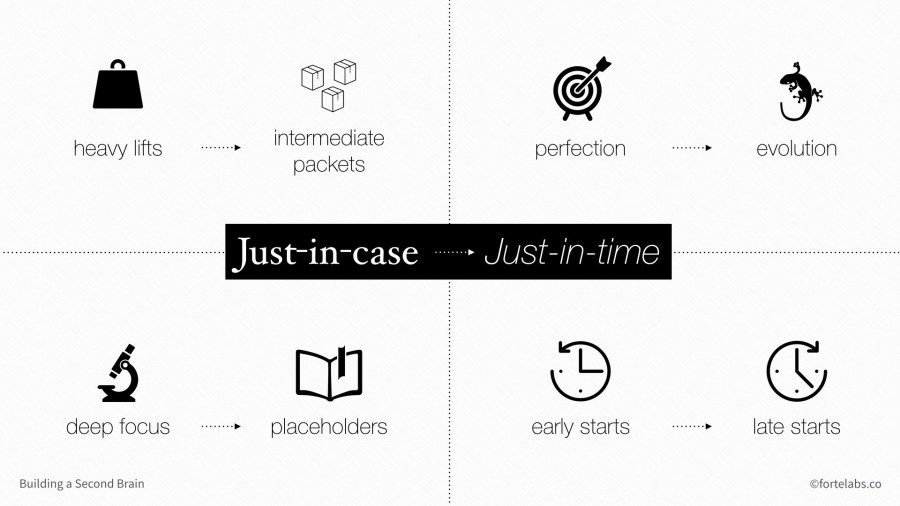
In Part 11, I introduced the concept of a “critical path” of tasks in a project, and the rationale for pushing tasks as late as possible on the timeline.
The late starts approach inspires a tremendous amount of resistance, especially from creative knowledge workers. It sounds an awful lot like taking control from individual employees, centralizing it in a central decision maker, and forcing people to finish everything at breakneck speed at the last minute.
It’s curious to note that the same people who tend to oppose late starts also pay homage to Toyota’s methods, loudly proclaiming their allegiance to books like The Lean Startup that were inspired by it. Yet no one mentions that early starts are the very antithesis of the just-in-time vision.
The truth is, if you adopt late starts in isolation, all these criticisms are valid. It only becomes possible (and humane) if enabled by the techniques we’ve covered in this series:
- Downscoping and upscoping: the ability to change the scope of a task to fit into whatever span of time is available (instead of assuming “it just takes as long as it takes”)
- Placeholders: the ability to “freeze” a task or deliverable in its current state, since late starts spread tasks in smaller chunks over a longer period of time, making batch processing difficult
- Intermediate packets: the ability to test assumptions (and therefore reduce uncertainty) by producing tangible artifacts; make handoffs between collaborators smoother (which is especially important on the critical path); and have a repository of existing deliverables that can be rapidly pulled together before a milestone
- Convergence and divergence: the ability to know whether you are diverging or converging, and adopting techniques that allow you to reliably deliver for a milestone
The techniques and tools we are learning in this series are designed to unlock the benefits of just-in-time action, while minimizing the downsides. These techniques allow teams greater flexibility on the Time and Budget sides of the Iron Triangle, in scheduling and sequencing, by giving individual workers control over the Scope side.
Just-in-Time PM also requires significant changes in the culture and politics of teams:
- Collaborators have to trust each other implicitly, because they will be sacrificing their own productivity to enable the productivity of others on the critical path
- Collaborators must have strong alignment and buy-in on the purpose of the work, because late starts prioritize the overall project at the expense of any single component
- Managers have to trust in people’s ability to self-manage and take responsibility, because late starts make projects more vulnerable to underperformance by any single contributor
- The environment must be one of openness and candor, since scheduling constraints can easily lead to unrealistic expectations and pressure
Although the question of when to start tasks may seem insignificant in the grand scheme of things, the stakes of this decision are high for digital knowledge workers. Working digitally tends to make the risks of early starts even worse, because there’s such a strong bias to starting things. It’s so easy and satisfying to set up a new project in Asana, a new channel in Slack, or a new Facebook group, but actually finishing things remains harder than ever.
At the same time, the potential benefits for digital teams are proportionally even greater:
- Spreading out tasks in shorter, more intense sprints (interspersed with easier work and time off) aligns more naturally with human rhythms, as opposed to a steady state like a machine
- It becomes easier for contractors and outside collaborators to work on such projects, because they can be called in only when needed, and then quickly disperse (which in turn makes it easier for more people to become freelancers)
- Not starting everything at once leaves more room at the beginning of a project for high-impact, creative activities, such as ideation, experimentation, and drawing on other disciplines (which have to be done early to be useful)
There is risk in just-in-time scheduling. It requires collaborators that are interdependent, and therefore vulnerable to each other. It requires everyone to have the freedom to rescope their own work as needed. It shifts emphasis from individual to project performance, potentially allowing people to avoid responsibility.
But I would rather adopt a project management approach that points toward a future in which these things are given, rather than defend against a past that is less relevant by the day.
From Just-In-Case to Just-In-Time Paradigm
Unlocking these benefits is about much more than task scheduling. It requires a revolution in mindset, from a Just-In-Case to a Just-In-Time paradigm.
Instead of suffering through grueling heavy lifts, we create many small, intermediate packets of value which can later be assembled into something greater. This allows us to remain grounded, balanced, and healthy, which is critical to doing our most creative work.
Instead of treating products as fixed objects, we evolve and morph their scope through a series of prototypes. We question our assumptions and seek maximum contact with reality, as early and often as possible. We evolve good solutions over time organically, instead of trying to engineer the perfect solution from scratch.
Instead of deep focus over long stretches of time, we create placeholders every step of the way, giving us the option to pivot to something else without losing our progress. What’s important is not choosing the right opportunity the first time, but being able to quickly change direction and move on the next one.
Instead of doing everything as soon as possible, which makes sense in a static, slowly moving environment, we do things as late as possible, to take advantage of the latest information. We build systems and routines allowing us to respond at the last minute, instead of pretending that we don’t need to.
Follow us for updates on Twitter, Facebook, Instagram, LinkedIn, or YouTube.
The Only Subscription
You Need to
Stay at the
Edge of AI
The essential toolkit for those shaping the future
"This might be the best value you
can get from an AI subscription."
- Jay S.
Join 100,000+ leaders, builders, and innovators

Email address
Already have an account? Sign in
What is included in a subscription?
Daily insights from AI pioneers + early access to powerful AI tools








Comments
Don't have an account? Sign up!